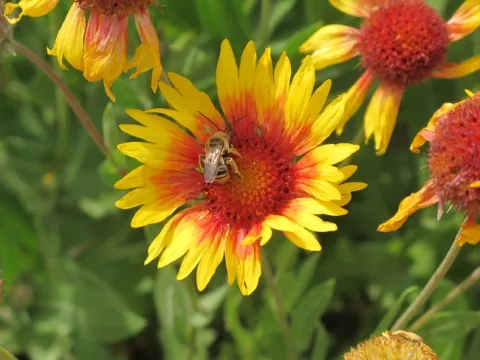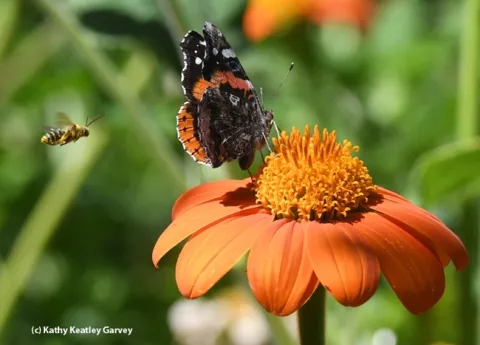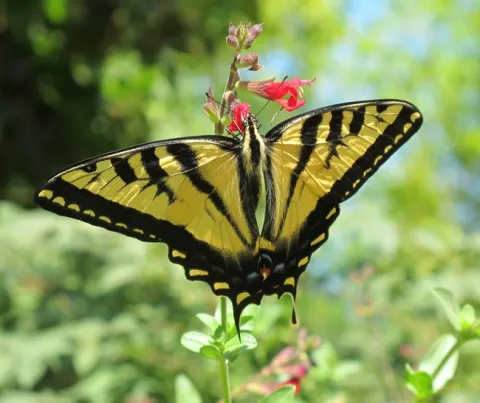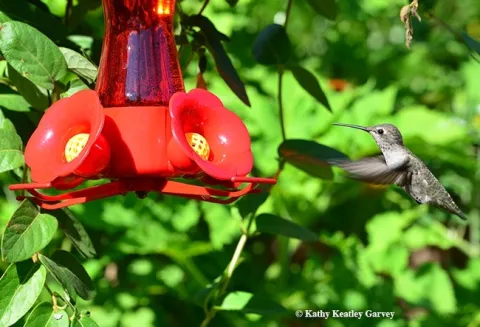In our previous blog, we posted a Pollinator Quiz. How did you do? Check the answers below to find out. Please post your responses in the comments section, or reply to the post on our Facebook page.

Question #1: What is pollination?
Pollination happens when pollen is moved by an insect, animal, or the wind. Pollen moves between the male part of a flower to the female part of either the same flower or another flower of the same species. This is how fertilization takes place and produces fruits and seeds.

Question #2: Which of the following are pollinators?
- (European) Honey bees
- Flies
- Wasps
- Butterflies
- Moths
- Hummingbirds
- Dragonflies
- Rats
- Native bees
- Lizards
- Beetles
All the above are pollinators, except for dragonflies, rats, and lizards! You may have been surprised to see flies, wasps, bats, and beetles listed. These pollinators help fertilize plants, although some are more efficient than others. You can support these animals and insects by planting a pollinator garden.

Question #3: What 3 important things do you need to provide in your garden to support pollinators?
When planning a pollinator garden, keep these 3 elements in mind:
Food
Flowers provide nectar (energy) and pollen (protein) for pollinators. However, moth and butterfly larvae (also called caterpillars) often rely on one specific plant for food.
To attract pollinators when planning your garden, purchase at least three of each kind of plant species and plant them in a group. This makes it easier for pollinators to find the plants and to return to your garden.
In fall and late winter, nectar and pollen resources are scarce, so look for plants such as Knifophia ‘Christmas Cheer,' California fuchsia (Epilobium spp.), various species of salvia such as ‘Mexican Sage' (Salvia leucantha) and Gooseberry (Ribes spp.). You can also visit nurseries and garden centers to see what's in bloom during those times.

Water
Many pollinators need water for survival. Bird baths and fountains attract hummingbirds and bees and help them stay hydrated. However, make sure your water source isn't too deep, or the pollinators may drown. Add pebbles or stones to shallow dishes and floating corks to deeper containers.
Shelter
Moths and Butterflies
In addition to providing food for moths and butterflies, larval food plants also provide shelter. If you remember the book The Very Hungry Caterpillar, these critters eat a lot! Make sure you have enough food, and be prepared to have your plants stripped bare of leaves if you get a lot of caterpillar visitors!
Native Bees
Seventy percent of native bees nest in the ground, so leave bare areas in your landscape for them. The other thirty percent nest in wood or a cavity created by another critter. Create bee boxes by drilling holes ¾ apart of various diameters between ¼ to ? inches. To see native bee photos, visit the UC Davis Arboretum & Public Garden page Beyond the Honey Bee. To create habitat for wood nesting bees, visit this Xerces Society page for directions.
Honey Bees
If you want to have your own hive, you can learn all about it and even take classes at UC Davis. Visit the Apiculture Courses page.

Online Resources
How to Attract and Maintain Pollinators in Your Garden
California Bee-Friendly Garden Recipes
Gardening for Pollinators
What You Might Not Know about Hummingbirds
Get to Know Common Local Native Bees
Print Resources
Frankie, G.W. et al. 2014. California Bees and Blooms, a Guide for Gardeners and Naturalists. Berkeley: Heyday books.
Jadallah, C. et al. 2017. Common Bees in California Gardens, UC ANR Publication 3552. (Bee identification cards, spiral bound.)
Shapiro, A.M., and T. Manolis. 2007. Field Guide to Butterflies of the San Francisco Bay and Sacramento Valley Regions. Berkeley: University of California Press.

